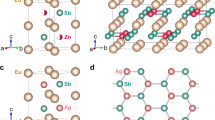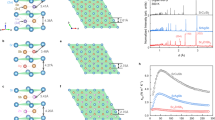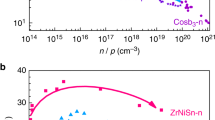Abstract
By converting waste heat into electricity, thermoelectric generators could be an important part of the solution to today's energy challenges. The compound Zn4Sb3 is one of the most efficient thermoelectric materials known. Its high efficiency results from an extraordinarily low thermal conductivity in conjunction with the electronic structure of a heavily doped semiconductor. Previous structural studies have been unable to explain this unusual combination of properties. Here, we show through a comprehensive structural analysis using single-crystal X-ray and powder-synchrotron-radiation diffraction methods, that both the electronic and thermal properties of Zn4Sb3 can be understood in terms of unique structural features that have been previously overlooked. The identification of Sb3− ions and Sb24− dimers reveals that Zn4Sb3 is a valence semiconductor with the ideal stoichiometry Zn13Sb10. In addition, the structure contains significant disorder, with zinc atoms distributed over multiple positions. The discovery of glass-like interstitial sites uncovers a highly effective mechanism for reducing thermal conductivity. Thus Zn4Sb3 is in many ways an ideal 'phonon glass, electron crystal' thermoelectric material.
This is a preview of subscription content, access via your institution
Access options
Subscribe to this journal
Receive 12 print issues and online access
$259.00 per year
only $21.58 per issue
Buy this article
- Purchase on Springer Link
- Instant access to full article PDF
Prices may be subject to local taxes which are calculated during checkout



Similar content being viewed by others
References
Caillat, T., Fleurial, J.P. & Borshchevsky, A. Preparation and thermoelectric properties of semiconducting Zn4Sb3 . J. Phys. Chem. Solids 58, 1119–1125 (1997).
Skrabek, E.A. & Trimmer, D.S. in Thermoelectric Handbook (ed. Rowe, D.M.) 267–275 (CRC, Boca Raton, 1995).
Uher, C. in Recent Trends in Thermoelectric Materials Research I (ed. Tritt, T.M.) 139–253 (Academic Press, San Diego, 2001).
Sales, B.C., Mandrus, D. & Williams, R.K. Filled skutterudite antimonides: A new class of thermoelectric materials. Science 272, 1325–1328 (1996).
Slack, G.A. in Thermoelectric Handbook (ed. Rowe, M.) 407–440 (CRC, Boca Raton, 1995).
Sales, B.C. Electron crystals and phonon glasses: a new path to improved thermoelectric materials. Mater. Res. Soc. Bull. 23, 15–21 (1998).
Mayer, H.W., Mikhail, I. & Schubert, K. Phases of ZnSbN and CdSbN mixtures. J. Less-Common Metals 59, 43–52 (1978).
Caillat, T., Borshchevsky, A. & Fleurial, J.-P. in Thermoelectric Materials - New Directions and Approaches. Symposium (eds Tritt, T.M., Kanatzidis, M.G., Lyon, H.B. Jr & Mahan, G.D.) 103–108 (Materials Research Society, San Francisco, California, 1997).
Tanaka, H. et al. ENIGMA: maximum-entropy method program package for huge systems. J. Appl. Crystallogr. 35, 282–286 (2002).
Bokii, G.B. & Klevzova, R.F. X-ray structure investigation of the beta-phase in the zinc-antimony system. Zh. Strukt. Khim. 6, 866 (English-translated pages 830–834) (1965).
Izard, V., Record, M.C., Tedenac, J.C. & Fries, S.G. Discussion on the stability of the antimony-zinc binary phases. CALPHAD 25, 567–581 (2001).
Kim, S.G., Mazin, II & Singh, D.J. First-principles study of Zn-Sb thermoelectrics. Phys. Rev. B 57, 6199–6203 (1998).
Kauzlarich, S.M. (ed.) Chemistry, Structure, and Bonding of Zintl Phases and Ions (VCH, New York, 1996).
Papoian, G.A. & Hoffmann, R. Hypervalent bonding in one, two, and three dimensions: Extending the Zintl-Klemm concept to nonclassical electron-rich networks. Angew. Chem. Intl Edn 39, 2409–2448 (2000).
Rowe, D.M. (ed.) CRC Handbook of Thermoelectrics (CRC, Boca Raton, 1995).
Chung, D.Y. et al. CsBi4Te6: A high-performance thermoelectric material for low-temperature applications. Science 287, 1024–1027 (2000).
Miller, R.C. in Thermoelectricity: Science and Engineering (eds. Heikes, R.R. & Ure, R.W.) 405–407 (Interscience, New York, 1961).
Funke, K. in Superionic Solids and Solid Electrolytes Recent Trends (eds Laskar, A.L. & Chandra, S.) 569–629 (Academic, San Diego, 1989).
Souma, T., Nakamoto, G. & Kurisu, M. Low-temperature thermoelectric properties of alpha- and beta- Zn4Sb3 bulk crystals prepared by a gradient freeze method and a spark plasma sintering method. J. Alloy. Comp. 340, 275–280 (2002).
Shaver, P.J. & Blair, J. Thermal and electronic transport properties of p-Type ZnSb. Phys. Rev. 141, 649–663 (1966).
Yvon, K., Baillif, R. & Flukiger, R. Positional disorder and nonstoichiometry in Cu2-XMo3S4 compounds 2: Triclinic low-temperature structure of Cu2-XMo3S4 . Acta Crystallogr. B 35, 2859–2863 (1979).
Caillat, T., Fleurial, J.-P. & Snyder, G.J. Potential of Chevrel phases for thermoelectric applications. Solid State Sci. 1, 535–544 (1999).
Cahill, D.G., Watson, S.K. & Pohl, R.O. Lower limit to thermal conductivity of disordered crystals. Phys. Rev. B 46, 6131–6140 (1992).
Sheldrick, G.M. SHELXL-97 A Program for Crystal Structure Refinement (Univ. Göttingen, Germany, 1997).
Nishibori, E. et al. The large Debye-Scherrer camera installed at SPring-8 BL02B2 for charge density studies. Nucl. Instrum. Methods A 467, 1045–1048 (2001).
Takata, M., Nishibori, E. & Sakata, M. Charge density studies utilizing powder diffraction and MEM. Exploring of high Tc superconductors, C-60 superconductors and manganites. Z. Kristall. 216, 71–86 (2001).
Acknowledgements
We would like to thank Philippe Rabiller, Sossina Haile, Franck Gascoin and Peter Stephens for discussions and preliminary results, and Helena Kauppila for Ga-doping experiments. The Danish Research Councils are acknowledged for funding through the DANSYNC centre, and access to a 512-node PC cluster at the Danish Supercomputer Centre, Southern Denmark University. E. N. thanks M. Sakata and M. Takata for valuable discussions, and K. Kato for experimental help at SPring-8. The synchrotron radiation experiments were performed at beam line BL02B2 at SPring-8 with the approval of the Japan Synchrotron Radiation Research Institute (JASRI). We also thank the European Commission for financial support under the NANOTHERMEL contract. This work was supported in part by the National Science Foundation Center for the Science and Engineering of Materials at Caltech and the Defence Advanced Research Projects Agency at the Jet Propulsion Laboratory under contract with NASA.
Author information
Authors and Affiliations
Corresponding author
Ethics declarations
Competing interests
The authors declare no competing financial interests.
Supplementary information
Supplementary Figures and tables
Fig. S1, Fig. S2, Table S1 and Table S2 (PDF 715 kb)
Rights and permissions
About this article
Cite this article
Snyder, G., Christensen, M., Nishibori, E. et al. Disordered zinc in Zn4Sb3 with phonon-glass and electron-crystal thermoelectric properties. Nature Mater 3, 458–463 (2004). https://doi.org/10.1038/nmat1154
Received:
Accepted:
Published:
Issue Date:
DOI: https://doi.org/10.1038/nmat1154
This article is cited by
-
Recent progress in thermoelectric layered cobalt oxide thin films
NPG Asia Materials (2023)
-
Rational design of stretchable and highly aligned organic/inorganic hybrid nanofiber films for multidirectional strain sensors and solar-driven thermoelectrics
Science China Materials (2023)
-
Intriguing metal–semiconductor transport properties on Se-substituted β-Zn4Sb3 compounds
Bulletin of Materials Science (2023)
-
Low Thermal Conductivity and Enhancement in Figure-of-Merit in Na and Mg Co-doped β-Zn4Sb3
Journal of Electronic Materials (2023)
-
Enhanced thermoelectric performance at elevated temperature via suppression of intrinsic excitation in p-type Bi0.5−xSnxSb1.5Te3 thermoelectric material
Journal of Materials Science: Materials in Electronics (2022)



